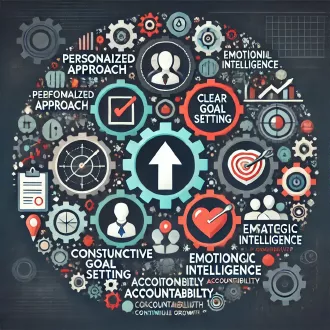Transcription Learn how to identify the behavior behind the actions.
In the field of team coaching and leadership, a fundamental skill lies in the ability to identify the underlying behavior behind the actions of team members. This skill goes beyond the obvious, allowing us to delve into the motivations, beliefs and emotions that drive individual behaviors. By understanding these internal dimensions, you gain a deeper and more accurate view of how individuals interact and contribute to the team as a whole.
People often must go a step further to identify behaviors in others. From these behaviors, specific details emerge that can be leveraged to get to know us better. However, it is important to challenge the learned tendency to label people with personality traits, such as "lazy" or "disinterested." Instead of labels, the focus should be on describing what they are doing, as attitudes and traits are not useful indicators in the developmental process.
It is crucial to recognize that the behaviors noted are manifestations of internal reactions. When someone speaks in a certain way, for example, this elicits a predictable reaction in others. This reaction is rooted in culture and shared perception. It is more effective to focus on observable and measurable behaviors, rather than making subjective interpretations about internal motivations.
When thinking about the client and how to improve the skills being developed, it is essential to break down each skill into specific, measurable behaviors. Each skill can be broken down into concrete actions that two people can independently observe and conclude. Doing so promotes a shared, objective understanding of progress.
Effectiveness lies in positively communicating expectations. Rather than focusing on what not to do, it is more constructive to point out what is expected and reinforce it in a positive way. By incentivizing desired behavior, team members are motivated to replace undesired patterns with actions more aligned with the team's goals.
An intelligent coach will guide his or her client toward identifying the correct behavior to replace those actions that do not contribute to the achievement of objectives. The ability to discern brings depth and clarity to team dynamics.
Here we will explore in detail how to learn to decipher the behavior behind the actions:
- Active listening and observation: your ability to listen actively and observe closely is critical. Your choice of words, facial expressions, body language and tone of voice can reveal what is really going on in the minds and hearts of team members.
- Deep questions: use open-ended, probing questions to explore beyond the surface. Asking "What led you to make that decision?" or "What is the purpose behind that action?" can unearth deeper motivations.
- Context and past experiences: understanding the context in which behavior takes place is crucial. Past experiences can influence how individuals react and behave in present situations.
- Pattern recognition: keep an eye out for patterns of behavior that repeat over time. Recognizing these tendencies can provide a clearer picture of how a person responds in various circumstances.
- Expression of emotions: expressed emotions provide important clues. Observe how team members react emotionally, as this can reveal their underlying concerns, desires and perceptions.
- Beliefs and values: explore the personal beliefs and values that influence individuals' actions. By understanding these fundamental beliefs, you can better understand the decisions they make.
- Organizational context: consider how the organizational environment and culture can influence behavior. Some actions may be responses to the pressures or expectations of the work environment.
- Empathy and connection: develop empathy and genuine connection with team members. By putting yourself in their shoes and understanding their perspectives, you will be able to discover their motivations and understand their actions from their point of view.
By applying these strategies, you will become an effective coach who can identify and decipher the underlying behavior of team members.
behavior




